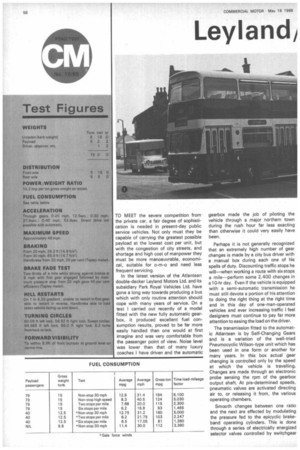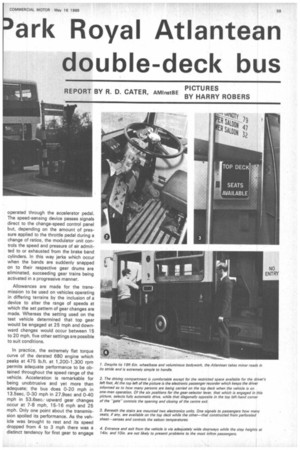Leyland) ark Royal Atlantean double-deck bus
Page 60

Page 61

Page 62

Page 65

If you've noticed an error in this article please click here to report it so we can fix it.
REPORT BY R. D. CATER, AMInstBE PICTURES BY HARRY ROBERS
TO MEET the severe competition from the private car, a fair degree of sophistication is needed in present-day public service vehicles. Not only must they be capable of carrying the greatest possible payload at the lowest cost per unit, but with the congestion of city streets, and shortage and high cost of manpower they must be more manoeuvrable, economical, suitable for o-m-o and need less frequent servicing.
In the latest version of the Atlantean double-decker Leyland Motors Ltd. and its subsidiary Park Royal Vehicles Ltd. have gone a long way towards producing a bus which with only routine attention should cope with many years of service. On a test I carried out recently of a model fitted with the new fully automatic gearbox, it produced excellent fuel consumption results, proved to be far more easily handled than one would at first imagine and was very comfortable from the passenger point of view. Noise level was lower than that of many luxury coaches I have driven and the automatic gearbox made the job of piloting the vehicle through a major northern town during the rush hour far less exacting than otherwise it could very easily have been.
Perhaps it is not generally recognized that an extremely high number of gear changes is made by a city bus driver with a manual box during each one of his spells of duty. Discounting traffic stops he will—when working a route with six stops a mile-perform some 2,400 changes in a 10-hr day. Even if the vehicle is equipped with a semi-automatic transmission he must still devote a portion of his attention to doing the right thing at the right time and in this day of one-man-operated vehicles and ever increasing. traffic I feel designers must continue to pay far more attention to easing the load on the driver.
The transmission fitted to the automatic Atlantean is by Self-Changing Gears and is a variation of the well-tried Pneumocyclic Wilson-type unit which has been used in one form or another for many years. In this box actual gear changing is controlled only by the speed at which the vehicle is travelling. Changes are made through an electronic probe sensing the rpm of the gearbox output shaft. At pre-determined speeds, pneumatic valves are activated directing air to, or releasing it from, the various operating chambers.
Smooth changes between one ratio and the next are effected by modulating the pressure fed to the epicyclic brakeband operating cylinders. This is done through a series of electrically energized selector valves controlled by switchgear operated through the accelerator pedal. The speed-sensing device passes signals direct to the change-speed control panel but, depending on the amount of pressure applied to the throttle pedal during a change of ratios, the modulator unit controls the speed and pressure of air adrnitted to or exhausted from the brake band cylinders. In this way jerks which occur when the bands are suddenly snapped on to their respective gear drums are eliminated, succeeding gear trains being activated in a progressive manner.
Allowances are made for the transmission to be used on vehicles operating in differing terrains by the inclusion of a device to alter the range of speeds at which the set pattern of gear changes are made. Whereas the setting used on the test vehicle determined that top gear would be engaged at 25 mph and downward changes would occur between 15 to 20 mph, five other settings are possible to suit conditions.
In practice, the extremely flat torque curve of the derated 680 engine which peaks at 475 lb.ft. at 1,200-1,300 rpm permits adequate performance to be obtained throughout the speed range of the vehicle. Acceleration is remarkable for being unobtrusive and yet more than adequate: the bus does 0-20 mph in 13,5sec, 0-30 mph in 27.9sec and 0-40 mph in 53.6sec. upward gear changes occur at 7-8 mph, 15-16 mph and 25 mph. Only one point about the transmission spoiled its performance. As the vehicle was brought to rest and its speed dropped from 4 to 3 mph there was a distinct tendency for first gear to engage
at incompatible engine rpm. This caused a sudden jerk which could—in my opinion —result in elderly passengers being jolted off their feet. Although I tried many different ways of handling this problem, all except one made not the slightest difference. And the one effective method —moving the overriding gear-selector lever into neutral each time a stop was approached—rather defeated the object of having fully automatic control.
After subsequent talks with SelfChanging Gears I learned that the only possible cause of jerky engagement of first gear under these conditions was a very slight maladjustment of the modulating unit. I have since been invited to drive a similar unit fitted into a test chassis upon which adjustment and maladjustment of the modulating valves can be undertaken, and will report my findings in a future issue of Commercial Motor.
The manual selector-control permits that the vehicle be driven in the normal semi-automatic manner. Personally I have no inclination to do unnecessary work and found that only by working extremely hard could the results of the automatic changes be bettered. There is often, of course, a need to hold a vehicle in a low ratio, either when descending a steep gradient or ensuring that a known hazard does not catch the vehicle on the wrong foot, as it were. For instance, approaching a blind corner on a slight downward gradient might cause the automatic box to change into a higher gear than the driver considers safe and here the overrider would ensure that the lower ratio was held until the hazard was passed.
For a vehicle which scaled around 15 tons the fuel consumption was good indeed. It was significant, I felt, that a high wind had far greater influence on the amount of fuel the vehicle used over a set route than the whole of its 5-ton payload. Although a figure of 12.9 mpg was returned on a windless day in the fully laden condition, during a gale on the second day of the test when half-laden and unladen consumption runs were made I found it possible to achieve only 12.75 mpg half-laden and, because of the increasing gale, 11.4 mpg unladen. Average speeds for these tests were 31.4 mph, 31.25 mph and 30 mph respectively.
By the second day of the test one or two points about the Park Royal body had made themselves felt. There is toc little space for the driver's left foot and the position in which the rocking footoperated valve—which controls the entry doors—is fitted, was too close and toc high for comfortable operation. The combination window panel in the offside 01 the cabin rattled badly at certain engine speeds and when either of the slidin,c sections was opened the resultinc draught around the back of the neck wa: atrocious. A panel at the left-hand real corner of the cabin had probably beer cleverly designed to stop draught from ar open signalling window troubling pas sengers in the first nearside seat. What not so bright is the effective manner ir which it turns that draught completeh, around so that the driver gets it on boll sides of his neck at the same time.
Once more I found it disappointing t( find visibility which is perfect in dry weather spoiled in rainy conditions lo■ inadequate wiper equipment. This wa: installed in such a way that a 12in. widi strip down the offside of the driver': screen is left unwiped. Although this ma, sound a trivial point, the resulting blini spot caused by droplets of rain reflectin! street and shop lighting makes th, driver's job extremely tiring on, for exam pie, those wet and murky evening
around Christmas when pedestrians seem to lose all regard for their safety. It should be remembered that rain is reckoned to fall on 60 days out of every 100 in Britain and if wide screens with slim pillars are really a necessity then so is a wiper which will clear the screen right up to the pillar.
I can only praise the bus's power steering. While its pleasant result was an easy, light action, not for one moment under any of the test conditions did I lose the complete feel of the vehicle. Nor once was there one of those horrible dead moments which occur with so many power steering gears and I found this particularly reassuring when the high winds encountered on the second test day buffeted the vehicle quite severely. Even then the tendency for the wind to push the bus off course could be accurately sensed and accounted for.
When I took the vehicle through Preston from the north side of the town at the junction of Yewlands Drive and A6, via the town centre, Fishergate, the railway station and out on to Blackpool Road to Penwortham, simulating a limited stop service, the five-mile journey was corn
pleted at an average speed of 17.3 mph without taking account of the seven stops of 8sec duration for picking up and setting down, or those incurred by traffic conditions. Fuel consumption was 8.9 mpg and the journey was finished with complete ease.
Surprise
A surprise was in store for me when carrying out brake tests. There are widely varying opinions as to what sort of braking efficiency should be built into a p.s.v. While some operators hold that an unladen vehicle should merely be capable of producing the required 50 per cent efficiency, and that drivers should make the necessary adjustments to their braking distances as the load increases, others insist that the full 50 per cent must be achieved in the fully laden condition and expect their drivers to use discretion when part-laden. As I have commented in previous p.s.v. road tests, I believe that a smaller risk of hurting passengers is involved in harsh braking than when, on the other hand, less sure braking allows a collision to occur.
The test Atlantean was well able to produce the required efficiency when fully laden, But the Leyland engineers who accompanied me on the test were not altogether satisfied with the results achieved initially. Because of this we took the bus into the garage to check that all was as it should be in the braking system.
The vehicle was fitted with SAB selfadjusting slack adjusters and although they had appeared to do their job very well—there were only a few thousandths of an inch clearance between the front liners and drums and a maximum .of 0.038in. between those on the rear wheels and their drums—by taking up this 0.038in. of adjustment the vehicle's braking figures were improved by no less than 6 per cent from 20 mph and 10 per cent from 30 mph.
Spring brakes are used for parking and these warrant mention for two reasons. First and probably most important for a bus is the fact that releasing of the spring brakes is instantaneous. Secondly their performance as a secondary brake was extremely good—they produced 29 per cent from 20 mph.
I have already said that passenger comfort was of a high order. Heating and ventilation equipment plays a large part in this and the Smiths Industries unit fitted kept the saloon temperature at a constant 63deg F when on automatic control and very much higher than that when the manual control was in operation. An SBK electronic passenger counter which keeps the driver informed how many passengers have gone up to the top deck also records the number of seats available for the benefit of passengers embarking.






















































































































